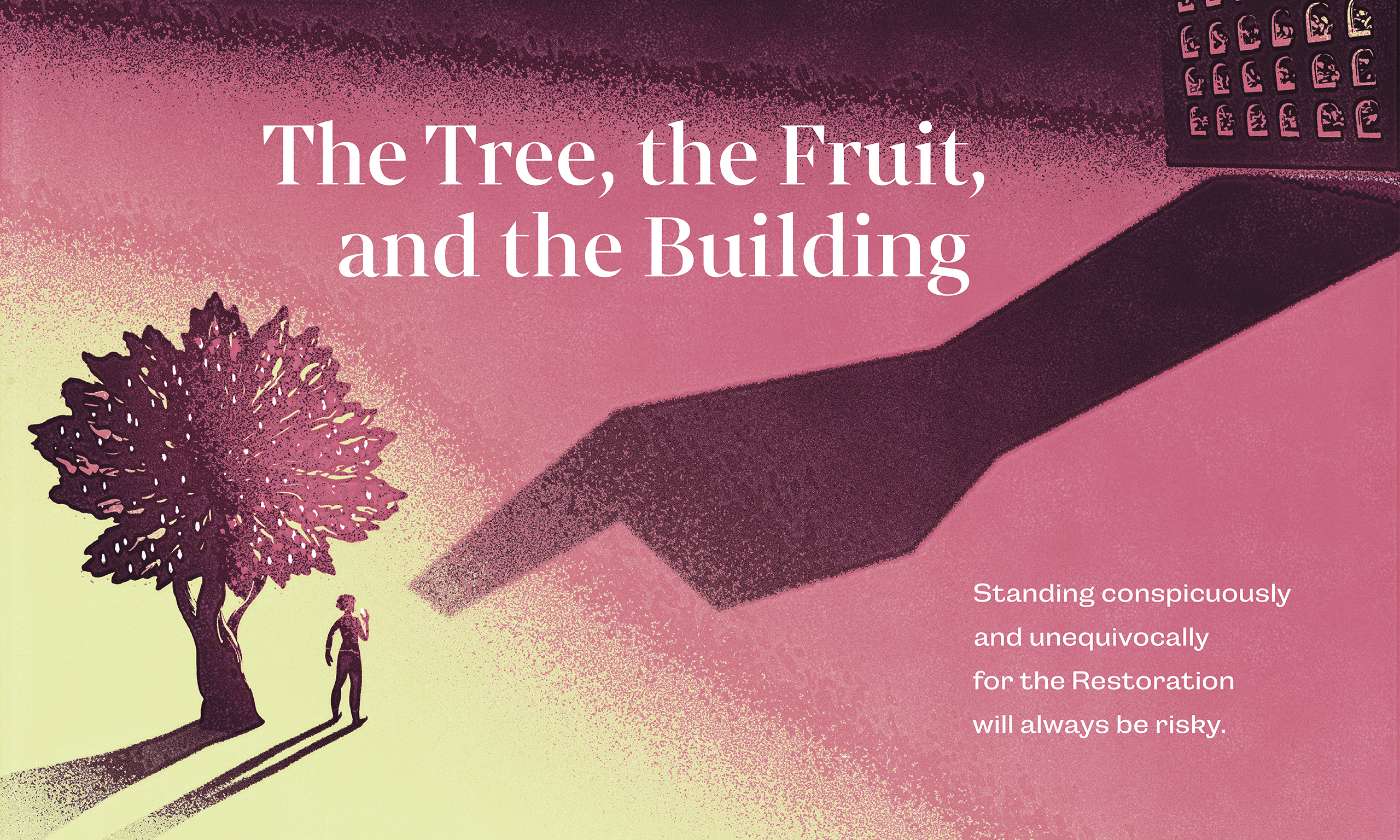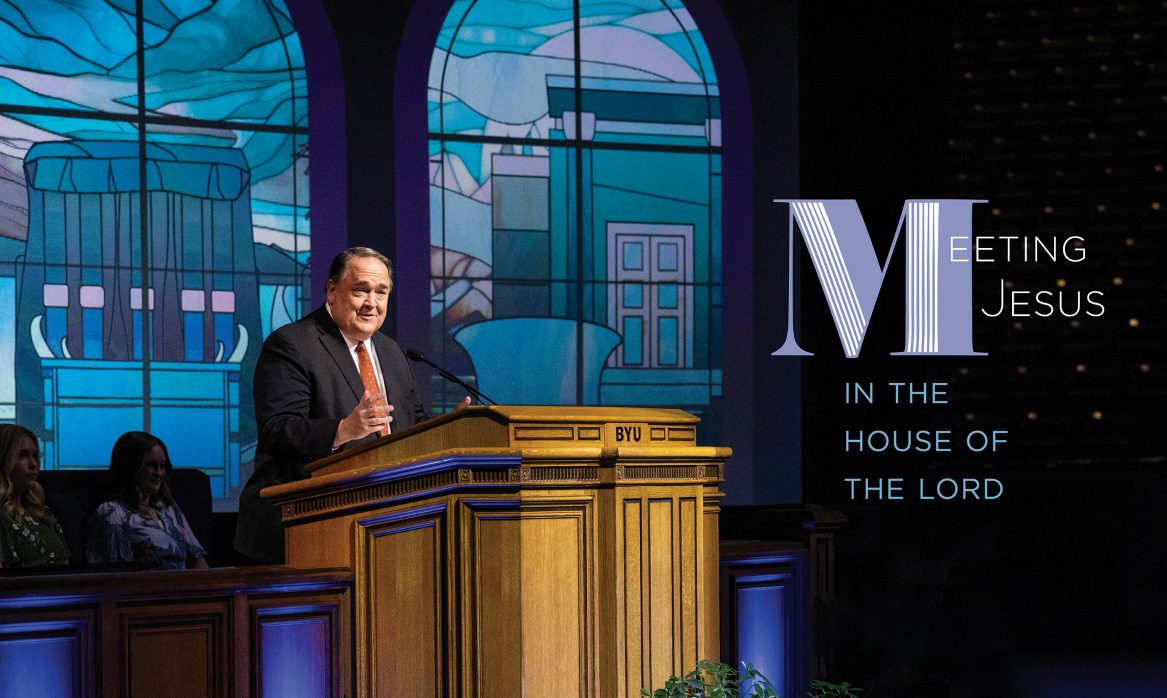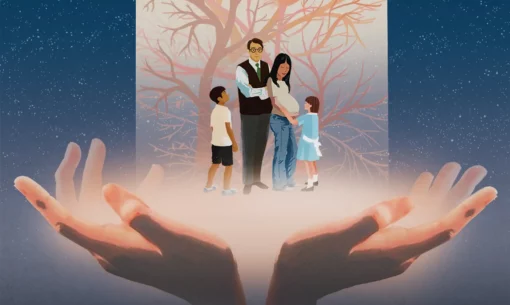The Tree, the Fruit, and the Building

The Tree, the Fruit, and the Building
Standing conspicuously and unequivocally for the Restoration will always be risky.
By Richard B. Anderson (BS ’91, MLIS ’93) in the Summer 2024 issue
Illustrations by Alex Nabaum
In my professional writing and speaking, my goal is always to determine and to convey effectively things that are both true and useful. I am trying to do that here as well—but with a big difference. In my professional speaking I try to focus on things that are contingently true and professionally useful. Today my hope is to share things that are radically true and eternally significant. My prayer is that I will share things that can be ratified in all of our hearts by the witness of the Holy Ghost and that, as a result, we will all be edified together (see D&C 50:22; 88:122).
Three Symbols in Lehi’s Vision
As we all know, the book of 1 Nephi in the Book of Mormon contains an account of a visionary dream given to the prophet Lehi in which he saw multitudes of people, a great and spacious building, a river, a path shrouded in a mist of darkness, and, along the path, an iron rod that led through the mist to a tree (see 1 Ne. 8).
Let’s remind ourselves briefly what the tree, the fruit, and the building represent in Lehi’s vision. According to the interpretation provided to Lehi’ son Nephi by an angelic guide, the great and spacious building represents “the world and the wisdom thereof” (1 Ne. 11:35), “the pride of the world” (1 Ne. 11:36), and the “vain imaginations and the pride of the children of men” (1 Ne. 12:18). Interestingly, Nephi needed no explanation of the symbolism of the tree; he immediately understood it to represent “the love of God, which sheddeth itself abroad in the hearts of the children of men” (1 Ne. 11:22). Representing as it did the love of God, the tree yielded a fruit that “was desirable to make one happy” (1 Ne. 8:10) and that, when Lehi partook of it, was “sweet, above all that [he] ever before tasted” (1 Ne. 8:11), and “filled [his] soul with exceedingly great joy” (1 Ne. 8:12).
In Lehi’s vision, what is the relationship between the great and spacious building and the tree and its joy-giving fruit? It is that the building, representing the pride and wisdom of the world, provided a platform to those who chose to enter it from which they could mock and scoff at those who “were partaking of the fruit” (1 Ne. 8:27), with the result that many of those partaking “were ashamed . . . ; and they fell away into forbidden paths and were lost” (1 Ne. 8:28).
The great and spacious building of Lehi’s vision is a symbol, but the cultural dynamic it represents is very real.
There are a couple of important things to notice here about the message of Lehi’s vision. First, those who abandoned the tree and its delicious fruit didn’t do so because they were disappointed by the fruit. From the information we have, we can assume that it was delicious to them and that it filled their souls with great joy. They seem to have dropped the fruit and walked away from it because they were embarrassed. They were embarrassed—and this is the second important thing—because they were being made fun of for eating the fruit by people who had never tasted it themselves but who were certain of one thing: partaking of the fruit of the love of God is stupid.
Why would they think that? Why would it bother them that other people might eat of the fruit and enjoy the rewards of doing so?
One possible answer to that question lies in the angel’s explanation of the nature of the great and spacious building. The tree—representing the love of God—and its joy-giving fruit are offered as an alternative to the world’s pride, vanity, and wisdom. Those who choose to remain outside of the building and partake of the fruit are, by doing so, rejecting the world’s pride and vanity in favor of the gospel, which—centered as it is in the Atonement of Christ—is the fruit of our Heavenly Father’s love for us.
Rejecting pride and vanity is one thing; even in the world, many would agree that both pride and vanity are problematic. But why would the people eating the fruit of the tree reject the world’s wisdom? (I think it is worth noting here, by the way, that there is nothing in the scriptures to suggest that the building represents the world’s knowledge—only its wisdom.)
The Bipartite Nature of Reality
To answer that question, we have to take a step back. One of the most fundamental facts upon which the restored gospel is based is that despite all appearances to the contrary, this world—in fact, what we can perceive and measure of our physical universe—is not all there is. Eternity, it turns out, is not just a word that denotes an endless and impersonal stretch of time. It refers to a world—to an order of things—that exists on the other side of a real but flimsy veil through which a personal God who is our literal Father in Heaven regularly reaches to reveal His will to us as individuals as well as to prophets and other true messengers charged with administering His church and building His kingdom on earth.
He does so primarily through the ministrations of the Holy Ghost, a member of the Godhead who is not physically embodied but is a personage of spirit. This allows the Holy Ghost to work upon our hearts and minds, sometimes in a directive and propositional way (revealing truth and prompting us to specific action) and sometimes to gift us with comfort, peace, and confirmation of truths both temporal and, especially, eternal.
This bipartite structure of temporal and eternal reality stands in direct opposition to the wisdom of the world, which denies that eternity exists. To affirm the existence of an eternal order is to commit an act of heresy against the orthodoxy of the world’s wisdom.
When it comes to the restored gospel, the chasm between what is true and what it is socially and academically acceptable to believe is just too wide for us to be able to stand with one foot on each side.

Christian religions do generally affirm the existence of a spiritual order, of course. So in 1820 when the young Joseph Smith emerged from the woods near his home having been visited, spoken to, and instructed by God the Father and Jesus Christ, he might reasonably have expected support from religionists who shared his conviction of the reality of eternal things. Unfortunately, however, in sharing his experience he committed a different kind of heresy—this one against the common sectarian orthodoxy holding that while the spiritual order exists, the veil separating it from the natural order is neither flimsy nor permeable but rather solid and unbreachable and that prophecy has ended and God no longer speaks to mankind.
In other words, for both secularists and religious sectarians, Joseph Smith’s doctrinal offense was that he claimed, as one contemporary commentator put it, “communion with angels and with the Divinity Himself” and “visions in the age of railways.”1
The Message of Lehi’s Vision for Us
But going back to Lehi’s vision: How might we liken these scriptures unto ourselves? (See 1 Ne. 19:23.)
Much has changed in the 200 years that have passed since Joseph Smith’s audience with God the Father and Jesus Christ, and in many ways Latter-day Saints have become much more accepted. But the actual truth claims of the Restoration continue to be “a stone of stumbling, and a rock of offence” (1 Peter 2:8) to many in the world and maybe even to a few in the Church. The great and spacious building of Lehi’s vision is a symbol, but the cultural dynamic it represents is very real. How easy should we expect covenant discipleship to be? How beloved of the world should disciples hope to be? To what degree should we expect revealed truth to harmonize with the philosophies of men?
Such questions go to a fundamental tension at the heart of academic life for Latter-day Saint students and scholars. In academia standing conspicuously and unequivocally for the Restoration will always be risky. We risk looking foolish, and we risk being seen as out of step with the current best thinking. We risk standing alone—sometimes, maybe, entirely alone. To stand for these particular truths in the world at large, but especially in an academic context, is to make ourselves countercultural.
Think of a starving Esau sitting before a bowl of stew, contemplating whether he should trade his birthright for it to satisfy his very real hunger (see Gen. 25:29–34). Now imagine that he is always hungry and that he sits in front of that stew all day every day and that it follows him to every classroom, every meeting, every conference, and every social-media platform. That is our situation. We constantly face the powerful and corrosive temptation to trade away our covenantal birthright in order to satisfy our appetite for delicious—but never really satisfying—worldly approval.
While Esau handed over his whole birthright in a single moment of hunger, our temptation is usually to do it more gradually, one small choice at a time. We might do it with a wink or a roll of the eyes intended to show our skeptical peers that while we may be in the Church, we are not fully of the Church. We might do it when someone makes derisive comments about the proclamation on the family2 and we look at our shoes. Or when we receive prophetic encouragement to “root out racism” in the Church3 and we murmur along with our like-minded friends about Church leaders getting too “woke.”
Now let me take a moment to say, parenthetically, that I know what you are thinking. You’re thinking, “But Rick, it’s easy for you to say this—you’re already a nerd. You’re a professional nerd. Socially, you’ve got nothing to lose by standing up for the gospel!”
And, honestly, I have to concede the point: I am a middle-aged, bow-tie-wearing, banjo-playing librarian; for me, the Ship of Coolness sailed a very long time ago. With no real hipness to safeguard, maybe I have less skin in this game than most of you.
But even if I am the wrong messenger, the message is still true. We can’t keep our covenants with a wink.
Real Choices and False Choices
When it comes to the restored gospel, the chasm between what is true and what it is socially and academically acceptable to believe is just too wide for us to be able to stand with one foot on each side. Christ was either physically resurrected or He wasn’t; the Book of Mormon can’t simultaneously be a genuine record of God’s dealings with real, ancient people and a 19th-century invention of Joseph Smith; Russell M. Nelson can’t simultaneously be a true prophet called of God and someone who is merely revered as a moral and organizational leader by members of the Church of Jesus Christ.
Please don’t misunderstand me here. Not all choices in life are binary: You can like both dogs and cats; you can love both classical music and K-pop. In fact, temporal or eternal is itself a false choice! Joseph Smith understood better than anyone that a recognition of the eternal elevates and ennobles the mundane and gives it holy significance by putting it in its true context.
For students and scholars, acknowledging and embracing the divine brings new and deeper meaning to every sonnet and sutra, every proof and theorem, every chemical structure, every line of philosophical or social inquiry, every language, and every art form. Our testimony of the eternal leads us to engage more deeply and more fully and more effectively with temporal learning and human society. But making and keeping sacred covenants with God does involve acknowledging some propositions as true and rejecting some others as false—and it does involve making and keeping commitments that necessarily entail the rejection of others.
In this context fidelity to the Restoration and to our covenant commitments acts, among other things, as a check on our intellectual vanity. If you want to overcome intellectual vanity, few things will help you do so quite as effectively as standing up in front of your academic peers and saying, “As a matter of fact, I believe that you can ‘get books from angels and translate them by miracles.’”4
If our first principles—those that are most foundationally important to us and that shape most deeply the way we think and the way we look at reality and our place in it—if our real first principles are the philosophies of men, then, unsurprisingly, we will find that we are most comfortable with the parts of our religion that align most snugly with those philosophies. And there are significant parts of the restored gospel that do that: service to others, caring for the poor, education. None of these important gospel priorities is going to get us into trouble with the world. No one gets mad at us for going to college and being nice to each other.
Problems arise for us socially when our first principles are eternal principles. Now, in addition to teaching that we need to serve each other and care for the poor and gain an education, we find ourselves testifying that God is a real, physically embodied person who is our actual Father, that Jesus was and is the resurrected Christ, that He speaks to living prophets in our day, and that eternal life requires entering into a covenantal relationship with God. Even more dangerously, we find ourselves testifying not only that God is real but that the veil dividing us from Him is permeable and that He can and does infringe on our space. These truths challenge the world’s furious and jealous claim to be all there is, and when we stand in defense of these truths, we have to expect pushback. We must be prepared, if necessary, to stand alone.
Becoming BYU
In his magisterial address titled “The Second Century of Brigham Young University,” President Spencer W. Kimball made a profoundly true observation: while we are engaged in the work of gospel-centered higher education, he said, “gospel methodology, concepts, and insights can help us to do what the world cannot do in its own frame of reference.”5 Here at BYU we are currently engaged in searching conversations about what “gospel methodology” can and should mean in the varying contexts of our work as students and faculty and staff. I hope we will also consider the implications of gospel concepts and insights for our lives as disciple-scholars—a term that, in this context, characterizes all of us in this room, whatever our role on campus. All of us are engaged in the work of a university whose mission “is to assist individuals in their quest for perfection and eternal life.”6
President Reese titled his inaugural response “Becoming BYU” and characterized that endeavor as the central challenge for his administration: “becoming the BYU of prophecy,”7 or what President Kimball called “the fully anointed university of the Lord.”8 That kind of phraseology will ring jarringly in the ears of those operating from the world’s frame of reference, but it will sing to any whose ears are tuned by covenant commitment and consecration.
It is also worth noting that the phrase “becoming BYU” contains an admonition as gentle in its formation as it is clear and direct in its implication: we can’t become what we already are. If today we need to “become BYU,” that means we are not yet, or at least not yet fully, “the Christ-centered, prophetically directed university of destiny and promise.”9 We will become that university, I believe, as we stand conspicuously and unambiguously for the truths of the restored gospel, and, in doing so, assist each other in our shared quest for perfection and eternal life.

I have no expectation that I will ever be provided external evidence sufficient to relieve me of the responsibility of choice or the burden of faith. And let’s be clear: faith is a burden as well as a joy.
My Testimony
I bear my witness that God the Father lives and is the Father of each of us in the most literal and meaningful sense. I bear testimony that Jesus Christ was and is God’s Only Begotten Son in the flesh and that He not only lived and ministered on earth, but also wrought an infinite Atonement on our behalf both in Gethsemane and on the cross by taking upon Himself the guilt for all of our sins and transgressions, thereby giving us the opportunity—if we so choose—to be delivered and cleansed of that guilt through repentance, baptism, and enduring fidelity to sacred covenants with God. I also testify that three days after dying on the cross, He rose as “the firstfruits of them that slept”, (1 Cor. 15:20) and by so doing vicariously overcame all of our injuries, illnesses, traumas, grief, and loss, ensuring that every one of us will be raised in resurrection as well, with perfected and glorified bodies joined permanently and irrevocably with our spirits. I don’t pretend for a moment to understand the process that allowed Him to do these things, but in the words of Peter, I “believe and [am] sure that [He is the] Christ, the Son of the living God” (John 6:69).
I also bear testimony that the Church is true: I “believe and [am] sure” that actual heavenly messengers, including God the Father and Jesus Christ, did, in fact, appear to Joseph Smith and that one of those messengers guided him to a physical book made out of metal plates; that the book contained an actual record of real people who lived in the Americas both before and after Christ; and that Joseph translated that record by the gift and power of God. I bear testimony of the subsequent restoration of priesthood authority in the latter days—authority that, when exercised in righteousness, yields genuine power both to serve and to lead in life-changing ways. With joy and without reservation, I sustain Joseph Smith as the first prophet called of God in the dispensation of the fulness of times and Russell M. Nelson as a prophet, seer, and revelator today.
Importantly, I can also bear testimony of the temple and of the covenants we make there. I can’t fully explain why I can do so, because there are a depth and a density to temple worship that defy my ability fully to comprehend it. But the depth and density of the temple impose a gravitational pull on both my soul and my intellect, drawing my mind to its teachings and my heart to the covenants we make there.
Engaging the gospel on a more experiential level through consecrated commitment yields something even better: faint but clear intimations of what eternity actually means.
I have no expectation that I will ever be provided external evidence sufficient to relieve me of the responsibility of choice or the burden of faith. And let’s be clear: faith is a burden as well as a joy. It is an ongoing commitment that requires us to hold our belief up above the floodwaters of doubt and opposition as we move forward through life and to hold fast to the iron rod of God’s word as we make our way through mists of darkness and confusion in this world. It also requires us to ignore the pointing fingers and the mockery of those who, having never tasted of the fruit of the tree themselves, think we are fools for partaking of it.
The restored gospel of Jesus Christ will reward every intellectual effort you invest in it. But as rewarding as intellectual engagement with the gospel is, engaging the gospel on a more experiential level through consecrated commitment yields something even better: faint but clear intimations of what eternity actually means and of your potential for eternal growth and development and deepening.
I can bear testimony that the Book of Mormon is not just a strange and beautiful literary document that rewards close and critical reading, though it is that, and that it is not just a container of true and saving doctrine, though it is that too. Perhaps even more importantly, the Book of Mormon is direct evidence of the reality of an eternal order and of the fact that Deity can and does breach the veil that separates that order from our temporal one. I testify that as we put both our minds and our hearts to work in studying and applying the truths of eternity, miracles will happen for us and, through us, for others.
If you are struggling, if you are in despair or confusion, please turn to Him who has promised not to leave you comfortless (see John 14:18). I invite you also to turn to the many of us arrayed around you who stand ready to help in any way we can. Our mission at BYU is not to sell you knowledge. Discovering, sharing, synthesizing, and creating knowledge with you are the primary means we use as we assist each other in our shared quest for perfection and eternal life.
The gospel is true. The Restoration is ongoing. The Church of Jesus Christ of Latter-day Saints is God’s kingdom on earth. We—every one of us—are His children, and our exaltation is His work and His glory (see Moses 1:39).
Understanding only imperfectly the depth of what it means to do so, I nevertheless bear this witness in the name of Jesus Christ, amen.
This text is condensed from a devotional address delivered April 2, 2024, by Rick Anderson, BYU university librarian. Find the full text, audio, and video at speeches.byu.edu.

Feedback Send comments on this article to magazine@byu.edu.
NOTES
- James Hannay and William Henry Wills, “In the Name of the Prophet—Smith!” Household Words: A Weekly Journal 3, no. 69, ed. Charles Dickens (July 19, 1851): p. 385.
- See “The Family: A Proclamation to the World” (Sept. 23, 1995).
- Dallin H. Oaks, “Love Your Enemies,” Ensign, November 2020; see also Dallin H. Oaks, “Racism and Other Challenges,” BYU devotional address, Oct. 27, 2020; Russell M. Nelson, “Let God Prevail,” Ensign, November 2020.
- Sterling M. McMurrin, in Blake T. Ostler, “7EP Interviews: Sterling M. McMurrin,” Seventh East Press: An Independent Student Newspaper, Jan. 11, 1983, p. 6; see also Ostler, “An Interview with Sterling M. McMurrin,” Dialogue: A Journal of Mormon Thought 17, no. 1 (Spring 1984): p. 25.
- Spencer W. Kimball, “The Second Century of Brigham Young University,” BYU devotional address, Oct. 10, 1975.
- The Mission of Brigham Young University (Nov. 4, 1981).
- C. Shane Reese, “Becoming BYU: An Inaugural Response,” address delivered at his inauguration as BYU president, Sept. 19, 2023.
- Kimball, “Second Century.”
- C. Shane Reese, “Perspective: Becoming BYU,” Opinion, Deseret News, Dec. 11, 2023, deseret.com/opinion/2023/12/11/23997519/c-shane-reese-what-byu-must-become.




